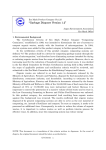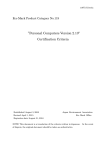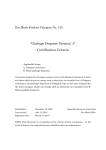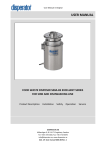Download “Garbage Disposer Version1.5” Certification Criteria
Transcript
Eco Mark Product Category No. 125
“Garbage Disposer Version1.5”
Certification Criteria
- Applicable ScopeA. Compost containers
B. Home garbage disposers
Containers designed to decompose organic wastes with biological treatment at home
and those which do not use energy such as electricity are classified into A.Compost
containers, and garbage disposers of biological type or dry type designed for
the above purpose which use energy such as electricity are classified into B.
Home garbage disposers.
Established:
December 18, 2002
Last revised:
July 13, 2012
Expiration date
March 31, 2016
Japan Environment Association
Eco Mark Office
NOTE: This document is a translation of the criteria written in Japanese. In the
event of dispute, the original document should be taken as authoritative.
125B V1 Criteria
Eco Mark Product Category No.125
“Garbage Disposer Version1.5”
Certification Criteria
B. Home garbage disposers
Japan Environment Association
Eco Mark Office
1. Purpose of Establishing Criteria
The Certification Criteria of Eco Mark Product Category “Composting
Containers,” established in 1989, was intended to disseminate the use of systems to
compost organic wastes, mainly with the functions of microorganisms. In 1994,
electric systems were added to this product category to further spread these
systems.
In the certification criteria of this product category, composting systems are
defined, "(1) The product shall be a device for composting garbage mainly through
the action of microorganism," and therefore have eliminating systems intended for
drying or reducing organic wastes from the scope of applicable products. However,
due to an increasing need for the reduction of household wastes in recent years, it
was decided in the Eco Mark Committee for Product Certification meeting held in
May 2000 that the scope of applicable products and certification criteria would be
reviewed, and submitted to the Eco Mark Committee for Establishing Category and
Criteria.
Organic wastes are referred to as food waste in documents released by the Ministry
of Agriculture, Forestry and Fisheries, disposed by food manufacturers, food
distributors, restaurant industry, and households. According to estimates by the
Ministry of Agriculture, Forestry and Fisheries in documents released by the former
Ministry of Health and Welfare in 1996, of the 19,400,000 tons of food waste that
were disposed of, 91% or 17,720,000 tons were incinerated and buried. Because it is
important to control the generation of a massive volume of food waste and to reuse
it, the Law Concerning Promoting to Recover and Utilize Food Resources was
enforced. In this product category, the environmental load resulting from organic
wastes against this background was reviewed. The results confirmed that organic
wastes disposed of by general composting systems are able to serve as the raw
material of composting, etc. instead of fertilizers and compost. To reuse as compost,
1/16
125B V1 Criteria
it needs to be processed an additional time. Consequently, in order to reduce the
volume of organic wastes, it is important to reduce wastes as well as perform
interim process for effective reuse. In addition, since the composting system may
reduce energy consumption during garbage incineration, it was decided that the
scope of application of composting systems would be reset, the reduction and reuse
of organic wastes promoted, and the supply of information on organic waste volume
reduction enhanced. To evaluate the product life cycle, the environment load
resulting in the manufacture and usage of the composting system was reviewed and
the appropriate certification criteria were established
2. Applicable Scope
Garbage disposers of biological type or dry type designed to decompose
organic wastes at home and those which use energy such as electricity. Collective
compost containers used in housing complexes are excluded.
3. Terminology
Biological type
Method
of
decomposing
organic
wastes
using
microorganisms in aerobic conditions to reduce volume.
Dry type
Method of drying organic wastes using energy such as
electricity to reduce volume.
Home
garbage Biological and dry disposing systems designed for home
disposer
disposal of organic wastes. These use energy like electricity
and exclude collective garbage disposers found in housing
complexes
Base material
Made of multi-porous wood, pulp, or other similar materials.
Used for the purpose of maintaining aerobic decomposition
conditions.
4. Certification Criteria and Certification Procedure
4-1. Environmental Criteria and Certification Procedure
(1) The standard power consumption of the system shall be below 1.5 kWh/kg at
this time.
[Certification Procedure]
2/16
125B V1 Criteria
The power consumption of the concerned systems shall be indicated in the
Attached Certificate. Power consumption measurement shall conform to
Composting System Performance Evaluation Criteria and Performance
Guidelines.
(2) Foamed plastic shall not use the specific CFCs (5 CFCs), other CFCs and
HCFC listed in Attachment 1.
[Certification Procedure]
Whether the plastic and the foaming agents are used is indicated in the
Attached Certificate. If they are used, whether fluorocarbons listed in the
Attachment 1 are used is also indicated in the Attached Certificates.
(3) Home garbage disposers must be designed with consideration to facilitating
the recycling of wastes.
[Certification Procedure]
Explanatory documents for the recycle design shall be submitted.
(4) The User's Manual shall provide the information listed in Attachment 2.
[Certification Procedure]
The User's Manual containing the information listed in Attachment 2 shall be
submitted.
(5) The User's Manual and the product label or pamphlet hall specify the
maximum power consumption in the operating state.
[Certification Procedure]
The corresponding sections of the User's Manual and the product label or
pamphlet shall be submitted.
(6) In manufacturing the applied product, related environmental laws and
regulations and pollution control agreement (hereinafter referred to as the
“Environmental Laws, etc.”) must be followed with respect to air pollution, water
contamination, noise, offensive odor, and emission of hazardous materials in the
area where the plant performing the final manufacturing process is located.
In addition, the state of compliance with the Environmental Laws, etc. for the last
five years from the date of application (whether there is any violation) must be
reported. If there is any violation, it is necessary that proper remedies and
preventive measures have been already taken, and the related Environmental
3/16
125B V1 Criteria
Laws, etc. must thereafter be followed appropriately.
[Certification Procedure]
With respect to the compliance with the Environmental Laws, etc. in the area
where the plant performing the final manufacturing process is located, a
certificate issued by the representative of the business of manufacturing the
applied product or the manager of the relevant plant (entry or attachment of the
list of names of the Environmental Laws, etc.) must be submitted.
In addition, it is necessary to report whether there is any violation during the
last five years, including a violation subject to administrative punishment or
administrative guidance, and if there is, the following documents in a and b
must be submitted:
a. With respect to the fact of violation, guidance documents from
administrative agencies (including order of correction and warning) and
copies of written answers (including those reporting causes and results of
correction) to such documents (making a series of progress clear);
b. Following materials (copies of recording documents, and so on) concerning
the management system for compliance with the Environmental Laws, etc.
in 1)-5):
1) List of the Environmental Laws, etc. related to the area where the plant
is located;
2) Implementation system (organizational chart with entry of roles, etc.);
3) Document stipulating retention of recording documents;
4) Recurrence prevention measures (future preventive measures);
5) State of implementation based on recurrence prevention measures
(result of checking of the state of compliance, including the result of
onsite inspection).
(7) Polybrominated biphenyl (PBB), polybrominated diphenyl ether (PBDE), or
chlorinated paraffin (chain carbon number of 10 to 13, with chlorine
concentration above 50%) shall not be added to plastic or printed-circuit boards as
prescription constituents. Printed-circuit boards are printed boards that do not
incorporate semiconductors.
[Certification Procedure]
Whether the plastic and the foaming agents of printed-circuit boards are used
and whether PBD, PBDE and chlorinated paraffin are used is indicated in the
Attached Certificate. In addition, parts procurement contracts, etc. shall be
submitted to certify that PBB, PBDE, and chlorinated paraffin have not been
4/16
125B V1 Criteria
added.
(8) Base materials shall be carefully kept from containing hazardous chemicals.
[Certification Procedure]
Raw materials of the base material shall be specified in the Attached
Certificates.
4-2. Quality Criteria and Certification Procedure
(9) Performance shall be verified in accordance with the "Home garbage disposer
Performance Evaluation Criteria and Performance Guidelines" at the end of this
Criteria or any quality standards equivalent to this. Quality control should also be
implemented adequately at the manufacturing stage..
[Certification Procedure]
A certificate indicating conformity to the corresponding quality criteria shall be
submitted. At the same time, a certificate issued by the manager of the plant
manufacturing the product, stating that quality control is being implemented
adequately and no laws have been violated in the manufacturing stage, shall be
submitted.
5. Product Classification, Indication and Others
Omitted.
December 18, 2002
Established
Dec. 26, 2003
Revised (Eco Mark Usage)
February 12, 2004
Revised (addition of criteria regarding to
flame retardants)
July 1, 2004
Revised (indication below Eco Mark Version1.1)
November 1, 2004
Revised
August 3, 2006
Revised
October 19, 2006
Revised Version1.2
October 5, 2007
Revised
August 21, 2008
Revised Version1.3
March 1, 2011
Revised Version1.4
July 13, 2012
Revised Version1.5
5/16
125B V1 Criteria
March 31, 2016
Expiration date
The Certification Criteria for the Product Category will be revised when necessary.
6/16
125B V1 Criteria
Attachment 1
Specified CFCs
(5 CFCs)
Substances prescribed in 4-1. (10)
trichlorofluoromethane
dichlorodifluoromethane
trichlorotrifluoroethane
dichlorotetrafluoroethane
Chloropentafluoroethane
Other CFCs
CFCs substitute (HCFC)
Chlorotrifluoromethane
Pentachlorofluoroethane
Tetrachlorodifluoroethane
Pentachlorofluoropropane
Hexachlorodifluoropropane
Pentachlorotrifluoropropane
Tetrachlorotetrafluoropropane
Trichloropentafluoropropane
Dichlorohexafluoropropane
Chloroheptafluoropropane
Carbontetrachloride
1,1,1-trichloroethane
Dichlorofluoromethane
Chlorodifluoromethane
Chlorofluoromethane
Tetrachlororfluoroethane
Trichlorodifluoroethane
Dichlorotrifluoroethane
Chlorotetrafluoroethane
Trichlorofluoroethane
Dichlorodifluoroethane
Chlorotrifluoroethane
Dichlorofluoroethane
Chlorodifluoroethane
Chlorofluoroethane
Hexachlorofluoropropane
Pentachlorodifluoropropane
Tetrachlorotrifluoropropane
Trichlorotetrafluoropropane
Dichloropentafluoropropane
Chlorohexafluoropropane
Pentachlorofluoropropane
Tetrachlorodifluoropropane
Trichlorotrifluoropropane
Dichlorotetrafluoropropane
Chloropentafluoropropane
Tetrachlorofluoropropane
Trichlorodifluoropropane
Dichlorotrifluoropropane
Chlorotetrafluoropropane
Trichlorofluoropropane
Dichlorodifluoropropane
Chlorotrifluoropropane
7/16
125B V1 Criteria
Dichlorofluoropropane
Chlorodifluoropropane
Chlorofluoropropane
8/16
125B V1 Criteria
Attachment 2 Particulars Required in User's Manual on Home garbage disposers
The following shall be taken into consideration when writing descriptions in the
User's Manual
Disposed wastes that have been reduced in volume (hereafter referred to as
disposed wastes) can serve as the raw material of compost, instead of compost
itself.
Each user should be individually responsible for the disposal of wastes.
The User's Manual shall provide the following information for the compost
container to achieve sufficient performance.
1. Manufacturer (logo if possible), product name and number shall be indicated.
2.Indications to ensure safety (Safety precautions)
Warning and cautions to ensure safe use and prevent injuries and damage to
assets in use of the product shall be provided (They are not applicable in the
case of malfunction or insufficient performance due to defect of the product.)
3. Name and function of main parts
Drawings and photographs shall be used to describe the names and functions of
main parts requiring sufficient understanding of users prior to use.
4. Installation (Installing method)
The site and method of installation shall be indicated. Units to be installed
outdoors shall describe potential risks if the disposer is used indoors.
5. Preparations (Prior to use)
The procedure for preparing to use the system such as checking and connecting
components and accessories shall be described specifically.
6. Precautions on use
Handling precautions on causes of malfunctions and damage to the product,
acts which disable the product from achieving the required functions and
performance shall be indicated.
[Examples]
- Waste etc. that can be disposed and what cannot
- General troubleshooting
7. Using the system (How to use the system)
The method of using the system shall be explained clearly from the standpoint
of the user.
[Examples]
- General principle on volume reduction
9/16
125B V1 Criteria
- Start of volume reduction
- Addition of organic wastes and base material
- Stirring
- Temperature and humidity appropriate for volume reduction
- Appraisal on whether volume reduction was successful
8. Handling of disposed waste
The following information shall be included.
(1) Precautions on use for gardening
(a) Use for home gardening shall be carried out at the user's own
responsibility.
(b) In the case of (a), the method of use recommended by the manufacturer
(in the User's Manual) shall be followed.
(c) Precautions for (a)
- When using as fertilizer, the compost shall be matured for a certain
period of time as recommended. If dispersed without doing so, it may
have adverse effects on plants.
-In particular, dispersing disposed waste which has been treated only for
a short period of time will increase the risk of adverse effects on plants.
(2) Precautions on storage over a long period of time
(3) To throw away disposed waste, it can be treated as burnable garbage since
its volume has been reduced.
9. Ideal way of using disposed waste
Any know-how and tips for effective use that will be more likely to produce the
expected function and performance shall be indicated.
10. Replacement of parts (addition and replacement of base material)
For consumable parts (base material) that need to be added (replenished) or
replaced, how to determine the time of addition and replacement, and
replacement method, etc. shall be described.
11. Inspection
If any daily or periodic inspections are required to ensure ideal and safe use,
why they are necessary and how they are carried out shall be provided.
12. Maintenance
To maintain product performance, the need for cleaning and maintenance and
method shall be described.
13. Determining malfunctions (what to do when malfunction is suspected)
Guidelines (table) to determine if the system has malfunctioned when it stops
operating normally in use and how to cope with the problem shall be provided.
10/16
125B V1 Criteria
14. Specifications
Product specifications such as power supply, electric power consumption,
maximum power consumption, dimensions, and weight shall be described.
15. Options
Options sold separately (materials) for replacing or replenishing parts
(materials), and expanding functions in the use of the product shall be
described.
16. Guarantee and after-sales service
The following information shall be included.
- Guarantee
- Request for repair
- Period of time while repair parts are available shall be 6 years after the cease
of manufacturing of the product
- Customer desk for inquires and repairs
- Precautions on safety inspection and safe use of products used over a long
period of time
17. Manufacture information
The following items shall be included to clarify the responsibility for issuing the
User's Manual.
- Company name
- Head office address and telephone number
- Name, address, and telephone number of product planning division
18. Others
The following shall be specified.
- Precautions taken when filling container (recommended)
- Remove moisture (roll in newspaper, dry in windy place, dry in the sun)
- Better to cut up large wastes into smaller parts
- Be cautious about what to include (avoid including liquids (water), oil (do
not include oil), fish/meat (protein), etc. in large amounts, because these
cause odor)
- Handling microorganisms
- Aim not at rotting but volume reduction.
- For biological composting, precautions on possibility of contamination by
microorganisms and population fluctuations in indoor use (sealed off space)
shall be added.
11/16
125B V1 Criteria
Home Garbage Disposer Performance Evaluation Criteria and Performance
Guidelines
1. Product definition
(1) System
A system that reduces the volume of organic waste efficiently using electric
energy.
A secondary advantage of the system is that it can convert the disposed waste
into reusable resources such as raw materials for composts. There are biological
and dry systems.
(2) Processing object
Organic wastes disposed from households.
The approximate volume of wastes disposed per day is 300-3,000 grams.
(3) Rated voltage
The commercial AC power is 100 V or 200 V.
(4) Site
For installation in general households (apartments and houses). Indoor and
outdoor types are available.
2. Test conditions
The test conditions are as follows (the same for all items):
Temperature: 20±2 ℃
Humidity:
60±10%
Voltage:
100V or 200V (based on rated voltage)
Frequency:
50Hz, 60Hz
Applicable wastes:
Standard test organic wastes of the standard quantity are
filled into the system. In addition, 700 grams (average weight of
organic wastes per day for a family of four.) can be measured
separately for reference. Note that "standard quantity" is the rated
weight (g or kg) of organic wastes that can be treated smoothly
every day in the standard operating conditions of the system for the
designated nominal term.
For the biological system using aerobic fermentation, "can be
treated smoothly" requires the condition that the moisture content
of the base material should be below 75% to control the anaerobic
fermentation state that occurs in high moisture levels. When the
high moisture level continues, the aerobic fermentation state
12/16
125B V1 Criteria
usually shifts to anaerobic fermentation state, and the emission
from the base material changes from the normal ammonia gas to
malodorous acetic gas. For the dry type, the rated quantity of
organic wastes shall be filled in the system to ensure sufficient
dryness.
Replacement of base material: Criteria for replacement of base materials of the
biological type depend on the manufacturers’ decision.
3. Power load and power consumption
3-1. Power load
The maximum power load is the watt measured in operating conditions with
maximum load imposed. (Operating condition with the maximum load imposed is
the condition in which the system can demonstrate maximum performance within
the operating temperature range. In other words, it is the operating mode in which
the system is filled with the maximum possible quantity of organic wastes, and
where it can demonstrate other added functions the most <deodorize function,
etc.>.)
3-2. Power consumption
(1) The power consumption is the electric energy consumed from start to end of
treatment of the standard test organic wastes (standard quantity) filled into the
system in the standard operation conditions of the system.
(2) The power consumption of the biological type is affected by the treatment state
of the base material and atmospheric temperature. Therefore, the standard test
organic materials of the standard quantity are filled into the system every day
based on "2. Test conditions" above to stabilize the treatment state. A watt-hour
meter is used to measure the integral power for one week in the stable
processing state. Electric energy used daily, or power consumption, is calculated
using the measurement.
The "stable processing state" for the biological system is nearly equivalent to the
state two weeks after continuous supply of organic wastes.
4. Reduced mass rate
(1) The percentage that indicates how much the organic wastes filled into the
system (g or kg) has been reduced after treating standard test organic wastes of
standard quantity.
(2) The reduced mass rate is measured for the nominal time with the dry type and
13/16
125B V1 Criteria
for 2 months with the biological type.
(3) With the biological type, measurement is done at two months when the reduced
mass rate stabilizes.
(4) Calculation equation
Reduced mass rate (%) = [total quantity of organic waste (kg) - {total mass at end
of test (kg) - total mass before test (kg)}] / total quantity of organic wastes (kg) x
100
(5) As the performance of the biological system varies according to the measuring
conditions such as region, season, and temperature and humidity of the
operating environment, the note "performance varies according to measuring
conditions such as region, season, and temperature and humidity of the
operating environment" shall be added.
(6) The reduced mass rate should be at least 70% in the above tests.
5. Treatment time
This is the index on the treatment speed of organic wastes. It is the time from
the start of processing after standard test organic wastes are filled into the system
to the end of the process.
With the dry type, it is the time until the designed dry rate is achieved or the
operating time that can be preset using a timer.
With the biological type, it is the operating time until the "state in which the
form of the standard test organic waste is no longer identifiable" is achieved.
However, the treatment time of the biological composting varies diversely
according to the type of organic waste, composition, size, and freshness. In actual
use, as the organic waste can be filled into the system over a long period of time
until the time of replacement of the base material, the length of the treatment time
is insignificant. Consequently, the treatment time for standard test organic wastes
is merely a reference for processing speed and should be treated carefully.
If the length of the treatment time is at issue in the biological system, the type,
composition, size, and freshness of the organic waste shall be clearly indicated: for
instance,
"Treatment time of boiled cabbage center measuring 3 cm in size is three
days."
From these reasons, it is appropriate to indicate the processing speed per time
for the dry type and the standard processing quantity per day for the biological type.
6. Noise
(1) Noise generated during the operation of the composting system.
14/16
125B V1 Criteria
(2) Measuring conditions are based on characteristics A of JIS Z 8731 noise level
measuring method.
(3) Supposing the system is operated in the standard state, noise levels are
measured 1 m away from the system at the front, right, and left sides, and the
average value is calculated. The height is the center of the system.
(4) Noise is measured for every operation when it changes due to operating states
such as stirring and ventilation. It is measured for every frequency when it
changes due to power frequency, and the maximum value is indicated.
7. Measures taken for odor
The product shall be deodorized and left open to the extent that it does not
affect the peripheral environment and residents. To deal with the issue of odor, the
following methods can be used; catalytic deodorizing system, aerobic microorganism
treatment, microorganism deodorizing method using specified bacteria, dilution,
duct emission, adsorption, electric discharge deodorization.
8. Safety
The system shall be designed with a safety structure conforming to the electric
equipment safety law, and appropriate warning notes and precautions shall be
labeled on the system or provided in the User's Manual to ensure safe use of the
product. (Equivalent to JEMA Anzen Hyoji Jissi Yoryosho (guidelines on safety
signs and indications)
Types, Contents, and Processing methods of Foods Used for Standard Test Organic
Vegetable
Wastes
Actual organic waste ratio
Waste Composition (weight ratio)
Vegetable
skin/scrap/
center
(leftover)
Fruit
skin/center
Cabbage
25
Potato
5
Onion
5
Radish
5
Apple
15
Orange or tangerine
15
70
Sub Total
15/16
Method of cutting
Cut into pieces of less than 10 mm
in width (including center)
Cut into quarters and then into
small pieces of 5 mm (with skin)
Cut into halves and then into small
pieces of 5 mm (including skin)
Cut into quarters and then into
small pieces of 5 mm
Cut into eight pieces vertically
(including center)
Cut into eight pieces vertically
(with skin)
125B V1 Criteria
Chopped into irregular
Raw meat
3 around 3 cm
Raw fish (sardine, etc.) 8 Cut into quarters
Chicken egg shell
2
13
pieces
Other
Meat
Meat
Fish
Egg shell
Sub Total
Vegetable and meat
total
83
Leftover food Rice or udon noodle
11
Tea dregs
Tea dregs
6 Used tea leaves
Sub Total
17
Total
100
*The composition of the organic wastes above is based on the following survey
results, but may be revised with lifestyle changes.
<References>
1. Survey Report of Sewerage and Sewage Purification Department, Ministry of
Land, Infrastructure and Transport
2. Survey Report of Bureau of Sewerage, Tokyo Metropolitan Government
3. Kyoto City Household Waste Disposal Survey Report
4. Nara Women's University Household Waste Survey
5. Survey by Composting System Monitors
16/16


























